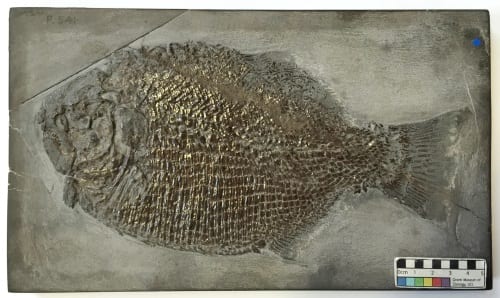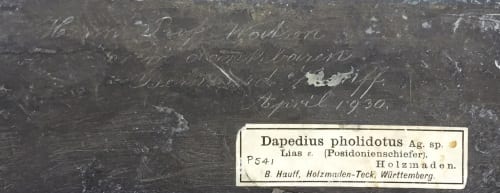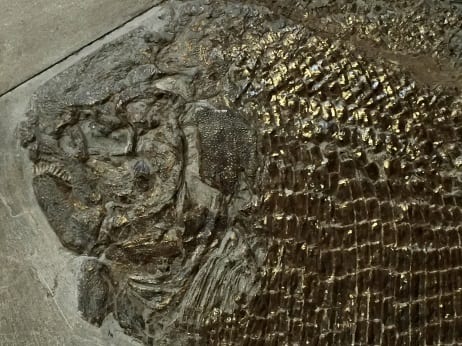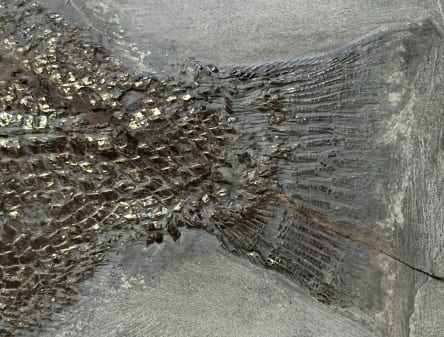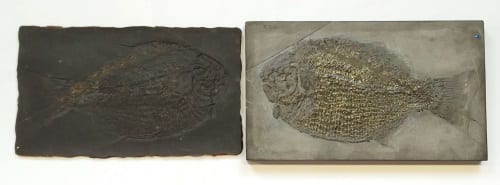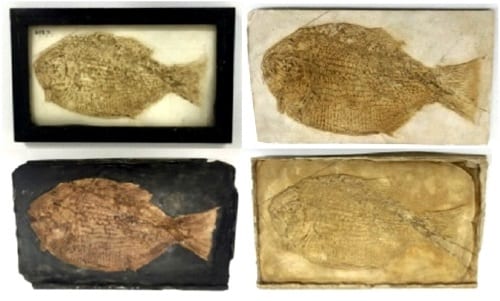Specimen of the Week 232: Holzmaden Fossil Fish
By Tannis Davidson, on 25 March 2016
There are quite a few posts on this blog regarding not-so-lovely fossil fish, which might possibly lead one to believe that the Grant Museum’s collection does not include fossil fish specimens of outstanding beauty. This is, however, definitely not the case. The Museum has many finely detailed, historically interesting, painstakingly prepared fossil fish – specimens that would, in fact, be described as anything but underwhelming.
This week’s Specimen of the Week is …
**The Holzmaden Fossil Fish **
Black Beauty
This magnificent specimen is a complete fossil of the extinct primitive neopterygian ray-finned fish Dapedium pholidotum. It is from the Posidonia Shale (a Lower Jurassic geological formation in south western Germany) and dates to approximately 180 million years ago. The formation (consisting of fine oil shale layers of bituminous marls) outcrops in the Holzmaden area and has been quarried in this area since the end of the 16th Century ¹.
Famous finds, famous friends
The quarrying in this area led to many sensational fossil finds such as the discovery of the outline of the body of a fossil ichthyosaur complete with skin impressions by Bernhard Hauff in 1892. This specimen was the first to clearly show an upright dorsal fin and fleshy upper tail lobe ².
By 1936 Bernhard Hauff founded the Urwelt-Museum Hauff in Holzmaden which (to this day) showcases many spectacular fossils found in the region prepared by the Hauff family. Just prior to this, Herr Hauff gave this Dapedium specimen to the Grant Museum’s curator at the time (and fossil fish authority) D. M. S. Watson :
Personally inscribed by hand and given from one great to another, the translation reads :
“Sir Professor Watson, With extreme gratitude, Bernhard Hauff, April 1930.”
The gift that kept on giving
Although it is unknown the reason for this fossil gift, the specimen itself was surely chosen as a particularly fine example of Dapedium. The fossil shows remarkable detail of the fish’s bony dermal plates around the skull, the rhomboid-shaped ganoid enamel-like scales which cover the body, and the intricate detail of the caudal fin area.
This specimen is so fine, in fact, that a rubber mould was produced which was then used to cast a number of copies. The Museum has the mould and four plaster casts of this specimen – all different colour combinations. It’s possible that these different options were produced as an experiment to determine how best to colour the plaster to highlight the details of the original fossil.
Perhaps these were made by students. Maybe these were used for teaching. Do any more exist? While each of these plaster casts highlights (in its own way) aspects of the original fossil, the stunning details which make this fossil so exceptional are not translated here. Due to the intricate nature of this fossil, it would be next to impossible to reproduce its elegant details – and certainly not with plaster. While digital scanning and 3D printing are poised to take over as the (hopefully-soon-to-be-commercially-viable) replication method of the future, the fact remains that you just can’t beat the original.
Tannis Davidson is the Curatorial Assistant at the Grant Museum of Zoology
References
¹. Selden, Paul & John Nudds 2004. Evolution of Fossil Ecosystems. The University of Chicago Press.
². Ibid.
 Close
Close


